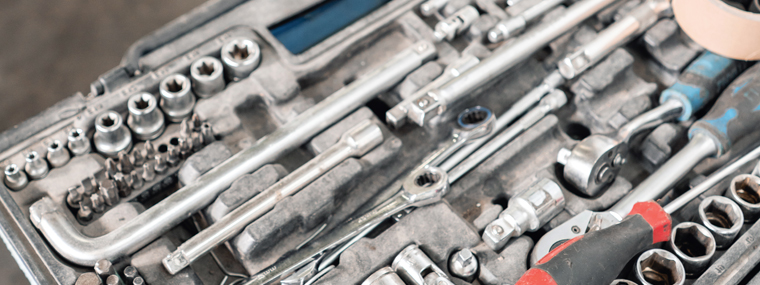
How to Set Up a Service Shop
By Diane M. Calabrese / Published March 2019

A kitchen and a service shop may seem worlds apart. They are not.
Beyond the basics, both spaces take shape in a way that incorporates the preferences of their owners. Make those preferences that are constrained by existing building codes, access to utilities, and the like—whether redoing or starting anew.
Experience is a good teacher in terms of what to change or improve. There’s also significant assistance available.
Professional organizations and manufacturers both provide access to great advice, says Al Bonifas, owner of All Spray in Swanton, OH. For instance, in May 2017, his team went through a dealer-management training course.
Even with his 35 years of experience in business, Bonifas found invaluable the recommendations of how to do things more efficiently. He says he felt that if he could just implement two percent of the suggestions, he would make gains.
“We moved into a new facility four years ago,” says Bonifas. “It was an auto dealership. It works for us.”
Before ever setting up a service shop, assess its viability, however. “You’ve got to have enough business going on,” says Bonifas.
Also, be sure to put together a team that understands how to meet goals. “We all do a little bit of everything here,” explains Bonifas.
“But you need job classifications,” says Bonifas. It becomes “too un-wieldy” without them.
“Our service shop has been in place since day one of our business inception,” says Jim O’Connell, president of Hotsy Pacific in Modesto, CA. “We consider it a critical part of our business. When you sell equipment, you have to be able to repair it either in house or on the road. All equipment breaks down from time to time, even new equipment.
“Over the years, our team has reconfigured the service shop a couple of times, mainly due to the growth of our company,” continues O’Connell. “We currently have two inside service techs at our main shop as well as a full-time prep department and custom installer.”
Changing for the better is an integral part of reconfiguration. “The most significant change was to add a full-time prep department and custom installer, for the fast turnaround of custom equipment,” says O’Connell.
When rethinking the setup of a service shop, there are plenty of ways to get ideas, such as books, videos, consultants, and especially those who have been there and done that. “I would reach out to a local service department that handles equipment comparable to us as well as talking to longtime distributors in our business who are successful,” says O’Connell.
When reflecting on the best arrangement for a service shop, keep in mind the shop’s tie to the rest of the business. “Sales and service work together as a team to not only support each other but to address specific needs that each department has,” explains O’Connell. “As an example, we may get a repair in the shop that is more than what a unit is worth. Service informs sales to reach out to the customer to offer a trade in on a new purchase, or sales has a specific configuration of a unit that the customer needs so they will work together to design the system.”
Movement, access, and quality of tools must be coupled with excellent staff. “The biggest mistakes would be not to have qualified technicians to repair equipment, and also not to have enough inventory to support the equipment sales,” says O’Connell. “Prompt and efficient service is a necessity to having a profitable operation.”
Of course, a service center must add to the bottom line. “Is service a profit center?” asks O’Connell.
“We treat our service as the most important thing we sell, not the equipment,” explains O’Connell. “We offer a fast turnaround and efficient service as well as loaners or rentals. Our goal is to have our customers have as little downtime as possible. And we make money doing that as well as keep our customers happy and coming back.”
School of Experience
Value insight acquired over time. Dennis Black, the president of McHenry Pressure Cleaning Systems Inc. in Frederick, MD, says that the school of experience provides good lessons when setting up a service shop.
“We have learned by doing, by our mistakes, and by borrowing what works from other distributors,” says Black. “Our association with CETA and its members has allowed us to visit and share with other members.”
A service shop is no more static than any other entity—everything changes. “Our current service area encompasses approximately 7,500 square feet,” says Black. “It has three bays, and we also have a separate 850 square-foot area that we use for fabrication and light painting, etc.”
Black has always had a service center. “Although when I first started, it consisted of a one bay car garage and outside parking lot area, meaning we worked on most units outside in all kinds of weather,” he explains.
Having moved to larger facilities three times and correspondingly set up new service areas, Black knows the importance of soliciting ideas and suggestions from those with intimate knowledge of service department needs. “As we have grown, I have delegated responsibility to our service manager and service personnel.”
The service center is important, and the team is important. For that reason, the team must be involved in planning for any changes in a service shop, says Black.
Think not only about workflow but also about space when making any changes to a service shop. Much of the change in the service shop at Black’s company is due to “growing in size,” he explains.
Being aware of “flow and efficiency” is a top concern, says Black, but it’s not the only one.
“We have projects that take multiple days or even weeks, so we cannot have that work clogging or restricting the smaller service work and basic in-and-out,” explains Black. “This is one reason we have created a separated area to do fabrication, welding, and paint work. We keep that work out of the repair area.”
By having a service shop, a distributor can offer more to a customer. Black considers a shop a must. “It is essential, integral—an important part of the value we offer to the customer.”
The value that customers expect has multiple dimensions that just begin with the purchase of a quality machine or ancillary. “It is safe to say that service and our abilities for special or custom work have maintained and gotten a large percentage of our business,” says Black. “Although we attempt to make service and sales two separate profit centers, they are very reliant on each other.”
Ease of “getting work in and out” of a service shop should be given a high priority, says Black. “We have struggled with the flow of areas to take in new work, area to do the service, and then area for completed work.”
That compartmentalization sounds simple enough, but there’s one potential obstacle. “Completed work can take up a lot of space,” says Black. “We strive to get customers’ work picked up or delivered as soon as possible after it is completed.”
And, then, there are the customers themselves. Customers must be kept out of the service area, explains Black. Their presence would pose a safety concern, and they can disrupt the activity of service technicians. “I always remember the example of car dealers,” says Black. “You do not go back where the service techs are working on your car.”
Safety and More
No service shop can be configured without attention to safety. Conversely, a well-designed service shop enhances safety.
An orderly service shop promotes safe work practices. It sounds prosaic, but everything has a place and that’s where each tool is when it’s not in use. Rummaging around is an activity that signals trouble in a service shop.
First aid kits, personal protective equipment, mechanical safety guarding, lockout/tag out are just the basics of safety requirements in a service shop. A recent study of machine shops by the Ohio Bureau of Workers’ Compensation at www.bwc.ohio.gov/downloads/blankpdf/MachineShops.pdf documented the dramatic reductions in workers’ compensation claims employers made simply by implementing the best practices available; two employers had no lost-time claims for four years.
A good result in a reasonable interval—make that fastest possible—is what customers seek from a service shop. A customer will appreciate electronic records, such as an immediately accessible service history for a pressure washer, if and only if the record truly speeds the process along. In addition, the digitally stored history of the machine will not impress the customer if a diagnosis can be quickly made, but a resolution must be delayed because it will take time to get parts.
Scope of service shop offerings must also be carefully considered. For example, will a shop offer loaner machines or work on equipment that is not sold by the distributor? For more on those related topics, revisit the March 2017 issue of Cleaner Times to read “Setting up a Service Repair Center” at www.cleanertimes.com/magazine/cleaner-times-articles-2/setting-service-repair-center.





